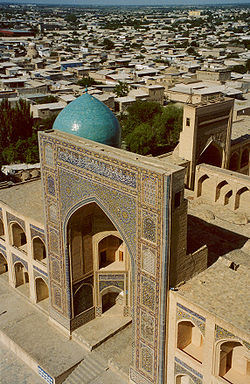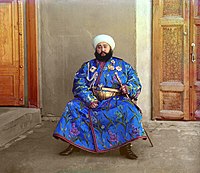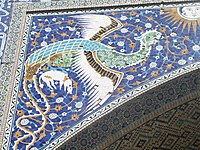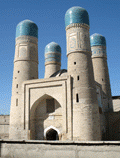| Bukhara Buxoro | |
| Mir-i Arab madrasah | |
|
Country |
|
|---|---|
|
Province |
Bukhara Province |
| Population (1999) | |
| - Total | 237,900 |
Bukhara (Uzbek: Buxoro, Tajik: Бухоро, Persian: بُخارا, Russian: Бухара), also spelled as Bukhoro and Bokhara, from the Soghdian βuxārak ("lucky place"), is the capital of the Bukhara Province (viloyat) of Uzbekistan. The nation's fifth-largest city, it has a population of 237,900 (1999 census estimate).
The region around Bukhara has been inhabited for at least five millennia and the city itself has existed for half that time. Located on the Silk Road, the city has long been a center of trade, scholarship, culture, and religion.
Contents |
Names
Bukhara was also known as Bokhara in 19th and early 20th century English publications and as Buhe/Puhe(捕喝) in Tang Chinese.
History
Bukhara has been one of the main centres of Persian civilization from its early days in 6th century BCE and since 12th century CE, Turkic speakers gradually moved in. Its architecture and archaeological sites form one of the pillars of the Central Asian history and art. The region of Bukhara was for a long period a part of the Persian Empire. The origin of its inhabitants goes back to the period of Aryan immigration into the region.
Iranian Soghdians inhabited the area and some centuries later the Persian language became dominant among them. Encyclopedia Iranica mentions that the name Bukhara is possibly derived from the Soghdian βuxārak ("Place of Good Fortune"). Another possible source of the name Bukhara may be from "a Turkic (Uighur) transfer of the Sanskrit word 'Vihara'" (monastery), and may be linked to the pre-Islamic presence of Buddhism, although this appears highly unlikely since the region was inhabited by Zoroastrians, and not Buddhists - nor was there ever any reference of a Buddhist monastery in the region.
The last emir of Bukhara was Muhammad Alim Khan (1880-1944). The Trans-Caspian railway was built through the city in the late 19th century. The historic center of Bukhara has been listed by UNESCO as one of the World Heritage Sites. It contains numerous mosques and madrassas.
Origin in Legends
According to the Iranian epic poem Shahnameh, the city was founded by King Siavash, son of Shah Kai Kavoos, one of the mythical Iranian kings of the Pishdak (Pishdādian) Dynasty. As the legend goes, Siāvash was accused by his step-mother Sudabeh of seducing her and even attempting to violate her. To test his innocence he underwent Trial by Fire. After emerging unscathed from amidst the flames, he crossed the Oxus River (now the Amu Darya) into Turan. The king of Samarkand, King Afrasiab, wed his daughter, Ferganiza (Persian: فرنگيس Farangis), to Siavash and further granted him a vassal kingdom in the Bukhara Oasis. There he built the Ark or Arg (Persian for 'citadel'), and the surrounding city. Some years later, Siavash was accused of plotting to overthrow his father-in-law and become the King of united Iran and Turan. Afrasiab believed this and ordered Siavash's execution in front of his own daughter and Siavash's wife, Farangis, and buried Siavash's head under the Hay-sellers Gate. In retaliation, King Kai Kavoos sent Rostam, the legendary super-hero of Iran, to attack Turan. Rostam killed Afrasiab, and took Farangis and Siavash's son, Kay Khusrau back to Iran (Persia).
Origin
Officially the city was founded in 500 BCE in the area now called the Arg. However, the Bukhara oasis had been inhabitated long before, since 3000 BCE an advanced Bronze Age culture called the Sapalli Culture thrived at such sites as Varakhsha, Vardan, Paykend, and Ramitan. In 1500 BCE a combination of factors; climatic drying, iron technology, and the arrival of Aryan nomads triggered a population shift to the oasis from outlying areas. Together both the Sapalli and Aryan people lived in villages along the shores of a dense lake and wetland area in the Zeravshan Fan (the Zeravshan (Zarafshan) River had ceased draining to the Oxus). By 1000 BC both groups had merged into a distinctive culture. Around 800 BCE this new culture, called Sogdian, flourished in city-states along the Zeravshan Valley. By this time, the lake had silted up and three small fortified settlements had been built. By 500 BCE these settlements had grown together and were enclosed by a wall, thus Bukhara was born.
Persian and Sassanid Empires
Bukhara entered history in 500 BCE as vassal state or satrapy in the Persian Empire. Later it passed into the hands of the Alexander the Great, the Hellenistic Seleucid Empire, the Greco-Bactrians, and the Kushan Empire. During this time, Bukhara functioned as a cult center for the worship of Anahita, and her associated temple economy. Approximately once a lunar cycle, the inhabitants of the Zeravshan Fan exchanged their old idols of the goddess for new ones. The trade festival took place in front of the Mokh Temple. This festival was important in assuring the fertility of land on which all inhabitants of the delta depended. As a result of the trade festivals, Bukhara became a center of commerce. As trade accelerated along the silk road after the Han Dynasty pushed back the northern tribes to secure this key trading route, the already prosperous city of Bukhara then became the logical choice for a market. The silk trade itself created a growth boom in the city which ended around 350 BCE. After the fall of the Kushan Empire, Bukhara passed into the hands of Hua tribes from Mongolia and entered a steep decline.
Prior to the Arab invasion, Bukhara was a stronghold for followers of two persecuted religious movements within the Sassanian Empire, that is, Manicheanism and Nestorian Christianity. When the Islamic armies arrived in 650 AD, they found a multi-ethnic, multi-religious and decentralized collection of peoples; nevertheless, after a century many of the subjects of the Caliphate had not converted to Islam, but retained their previous religion. The lack of any central power meant that while the Arabs could gain an easy victory in battle or raiding, they could never hold territory in Central Asia. In fact, Bukhara, along with other cities in the Sogdian federation, played the Caliphate against the Tang Empire. The Arabs did not truly conquer Bukhara until after the Battle of Talas in 751 AD. Islam became the dominant religion at this time and remains the dominant religion to the present day.
Islamic Era
|
This section has multiple issues. Please help improve the article or discuss these issues on the talk page.
|
Many prominent people lived in Bukhara during the Islamic era. For a century after the Battle of Talas, Islam slowly took root in Bukhara. In 850 AD Bukhara became the capital of the Samanid Empire, which brought about a revival of Iranian language and culture after the period of Arab domination. While under Samanid control, Bukhara was a rival to Baghdad in its glory. Scholars note that the Samanids revived Persian more than the Buyids and the Saffarids, while continuing to patronize Arabic to a significant degree.Nevertheless, in a famous edict, Samanid authorities declared that "here, in this region, the language is Persian, and the kings of this realm are Persian kings."
During the golden age of the Samanids, Bukhara became the intellectual center of the Islamic world and therefore, at that time, of the world itself. Many illustrious scholars penned their treatises here. Muhammad al-Bukhari, a prominent Islamic scholar who gathered the authentic sayings (hadiths) of the Prophet Muhammad, was born in this city. During this time Bukhara was by far the largest city in Central Asia and it was one of the biggest and most populated cities (having a population of over 300,000) in the world along with Córdoba, Cairo and Baghdad. The city was also a center of Sufi Islam, most notably the Naqshbandi Order.
In 999 AD the Samanids were toppled by the Karakhanid Uyghurs. Later, Bukhara became part of the kingdom of Khwarazm Shahs, who incurred the wrath of the Mongols by killing their ambassador, and in 1220 the city was leveled by Genghis Khan. The city slowly recovered, and was part of first the Chaghatay Khanate, then the Timurid Empire. It next became the capital of the Khanate of Bukhara and later the Emirate of Bukhara, which lasted until 1920, though it was a Russian protectorate for much of this time.
Ibn Hawqal gives a detailed account of the chief canals which, starting from the left bank of the Sughd river, watered Bukhara and the gardens in the plain around the city.
Bukhara – the Center of Enlightenment in the East
Many prominent people lived in Bukhara in the past. Most famous of them are:
- Muhammad Ibn Ismail Ibn Ibrahim Ibn al-Mughirah Ibn Bardiziyeh al-Bukhari (810-870)
- Avicenna (Abu Ali ibn Sina) (980-1037) - physician and person of encyclopedic knowledge
- Bal'ami: Abolfazl Muhammad and his son Abu-Ali Mohammad, two famous viziers of Samanid kings, historians and patrons of art and literature
- Abubakr Narshakhi (10th century) - the outstanding historian who wrote History of Bukhara
- Utabi (11th century)
- Ismatallah Bukhari (1365-1426) - known as Khawjeh Ismat, the illustrious poet during Timurids.
- Molana Abd-al-Hakim (16th century) - the renowned physician
- Mirza Abd al-Aziz Bukhari (the end the 18th century - the beginning of the 19th century) - the calligrapher.
- Rahmat-allah Bukhari (died in 1893) - the specialist in study of literature
At the third decade of 16th century, Bukhara became a capital of the Bukhara khanate, under the government of Shaybanid dynasty. The whole period when this dynasty was in power is about one century since the beginning of 16th century. The Shaybanid carried out many reforms during this time. In particular they instituted a number of measures to better system of the public education. Each neighborhood - "mahalla" unit of local self-government - of Bukhara had a hedge-school. Prosperous families provided home education to their children. Children started elementary education at the age of six. After two years they could be taken to madrasah. The course of education in madrasah consisted of three steps in sevens years. Hence, the whole course of education in madrasah lasted 21 years. The pupils studied theological sciences, arithmetic, jurisprudence, logic, music and poetry. Such way of education had a positive influence upon development and wide circulation of the Persian and Uzbek languages, and also on development of literature, science, art and skills.
To that period of Bukhara history belong the new books on history and geography - such as "Haft iqlīm" - "Seven Climates" by Amin Ahmad Razi, a native of Iran. Bukhara of 16th century was the centre of attraction for skilled craftsman of calligraphy and miniature-paintings, such experts were Sultan Ah Maskhadi, Mahmud ibn Eshaq Shakibi, the theoretician in calligraphy dervish Mahmud Buklian, Molana Mahmud Muzahheb, Jelaleddin Yusuf. Among famous poets and theologians who worked in Bukara of that time were Mushfiki, Nizami Muamaya, Mohammad Amin Zahed. Molana Abd-al Hakim was the most famous of many physicians who practiced in Bukhara and Khanate in 16th century.
At the time of government of Abd al-Aziz-khan (1533-1550) he established the library "having no equal" the world over. The prominent scholar Sultan Mirak Munshi worked there since 1540. The gifted calligrapher, Mir Abid Khusaini, well-wielded Nastaliq and Reihani handwritings, who was also brilliant miniature-painter and master of encrustation was the librarian (kitabdar) of Bukhara library. This information is contained in the anthology "Muzahir al-Ahbab" of Khasan Nisari.
In 19th century, Bukhara still played a significant part in regional cultural and religious life, as Demezon testified in 1833-34. He wrote, "The madrasahs in Bukhara are famed throughout Turkestan. Students come here from Khiva, Kokand, Gissar and even from Samarkand and also from many Tatar regions ... There are about 60 madrasahs in Bukhara that are more or less successful."
Russian Revolution
Bukhara entered the modern period as a colonial acquisition of the Russian Empire. It became a chess piece in the "Great Game" between Russia and Britain. The Bukharan People's Soviet Republic existed from 1920 to 1925. Then the city was integrated into the Uzbek Soviet Socialist Republic.
Major sights
Po-i Kalyan Complex
The title Po-i-Kalyan (also Poi Kalyan, Persian پای کلان meaning "The foot of the Great"), belongs to the architectural complex located at the foot of the great minaret Kalyan.
- Kalyan minaret. The minaret made in the form of a circular-pillar brick tower, narrowing upwards, of 9 meters (29.53 ft) diameter at the bottom, 6 meters (19.69 ft) overhead and 45.6 meters (149.61 ft) high.
- Kalyan Mosque (Masjid-i kalyan), arguably completed in 1514, is equal with Bibi-Khanym Mosque in Samarkand in size. Although they are of the same type of building, they are absolutely different in terms of art of building.
- Mir-i Arab Madrassah. There is little known about the Mir-i Arab Madrasah origin. The construction of Mir-i-Arab Madrasah is ascribed to Sheikh Abdullah Yamani of Yemen, the spiritual mentor of early Shaybanids. He was in charge of donations of Ubaidollah Khan (gov. 1533-1539), devoted to construction of madrasah.
Ismail Samani mausoleum
The Ismail Samani mausoleum (9th-10th century), one of the most esteemed sights of Central Asian architecture, was built in the 9th century (between 892 and 943) as the resting-place of Ismail Samani - the founder of the Samanid dynasty, the last Persian dynasty to rule in Central Asia, which held the city in the 9th and 10th centuries. Although in the first instance the Samanids were Governors of Khorasan and Ma wara'u'n-nahr under the suzerainty of the Abbasid Caliphate, the dynasty soon established virtual independence from Baghdad.
Chashma-Ayub mausoleum
Chashma-Ayub is located near the Samani mausoleum. Its name means Job's well due to the legend according to which Job (Ayub) visited this place and made a well by the blow of his staff. The water of this well is still pure and is considered healing. The current building was constructed during the reign of Timur and features a Khwarazm-style conical dome uncommon in Bukhara.
Lyab-i Hauz
The Lyab-i Hauz (or Lyab-i Khauz, Persian: لب حوض, meaning by the pond) Ensemble (1568-1622) is the name of the area surrounding one of the few remaining hauz (ponds) in the city of Bukhara. Until the Soviet period there were many such ponds, which were the city's principal source of water, but they were notorious for spreading disease and were mostly filled in during the 1920s and 1930s. The Lyab-i Hauz survived because it is the centrepiece of a magnificent architectural ensemble, created during the 16th and 17th centuries, which has not been significantly changed since. The Lyab-i Hauz ensemble, surrounding the pond on three sides, consists of the Kukeldash Madrasah (1568-1569), the largest in the city (on the north side of the pont), and of two religious edifices built by Nadir Divan-Beghi: a khanaka (1620), or lodging-house for itinerant Sufis, and a madrasah (1622) that stand on the west and east sides of the pond respectively.
Transportation
Bukhara Airport
Demographics
Bukhara (along with Samarkand) is one of the two major centres of Uzbekistan's Tajik minority. Bukhara was also home to the Bukharian Jews, whose ancestors settled in the city during Roman times. Most Bukharian Jews left Bukhara between 1925 and 2000.
Bukhara in poetry and literature
Being a cultural magnet, Bukhara has long appeared in much local and Persian literature. Many examples can be sought.
Dehkhoda defines the name Bukhara itself as meaning "full of knowledge", referring to the fact that in antiquity, Bukhara was a scientific and scholarship powerhouse. Rumi verifies this when he praises the city as such:
Notable people born or lived in Bukhara
- Baha-ud-Din Naqshband Bukhari
- Ibn Sina
- Zamakhshari
- Muhammad al-Bukhari
- Kiromi Bukhoroi
- An Lushan
- Oksana Chusovitina
- Hazrat Syed Jalaluddin Surkh-Posh Bukhari
Sister cities
These cities were major cities of Greater Khorasan:
Other cities:



















